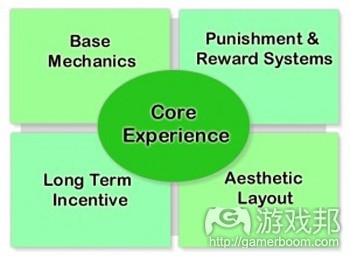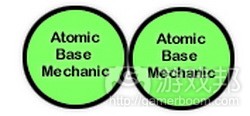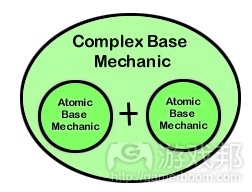分析游戏设计标准之基础机制
作者:Brice Morrison
Dave目前正在着手自己的大型独立游戏。他已把握题材和总体构思。这是款有关僵尸的动作/冒险游戏,玩家吸收受害者的血液。玩家得避免日光曝晒,游戏涉及浪漫爱情故事。听起来是款不错的游戏。
他向业内好友陈述自己的想法。他的激动之情溢于言表,他非常喜欢僵尸吸血这个游戏。但当好友问及:
“玩家如何盗取血液?”
Dave告知好友僵尸可以瞄准任何人,吸取他们的血液,这就是游戏的运作方式。但好友反复表示,“玩家点击什么按键?你如何通过按键点击传递僵尸盗取他人血液的信息?”
Dave低头不语,发现自己的构思虽然理论上看颇为有趣,但有些操之过急。
巧妇难为无米之炊
Dave的构思也许非常不错,但能否最终实现?这要看情况;构思都很好,但其中缺乏组织关系。Dave没有腾出时间创建游戏基础;他只是从某些有趣故事下手。若Dave草率动手,未先创建联系,就开始根据构思编码,游戏最终很可能只是款同其他作品大同小异的普通之作。也就是说游戏难成为轰动巨作。
要想构建僵尸体验,Dave需在制作初期思考基础机制。
就如之前提到的是,本系列的“游戏设计标准”是个分析和规划方式,游戏开发者可以凭此设定游戏轮廓、目标和用户体验。通过运用这些标准,设计师能够围绕预期核心体验创建游戏内容。
通过这一系列的游戏设计标准,设计师、开发商和用户能够描述和分析游戏的核心要素。此前我们就已谈及核心体验的重要性,就是开发者希望用户体验游戏时收获的感觉。本文主要谈论基础机制。
不妨先来看看一个类比例子。房子由砖块砌成。大家走进房子的时候不会想到砖块、木头和管道。新屋主不会像好友吹嘘房子使用什么泥浆;他们期望瞄准其他更优的元素!他们希望展示时髦木质地板、大理石案台,或者多层供暖设备。砖块是基础元素,若砖块的堆砌方式不当,那么其他都免谈。
同样,游戏也是由基础机制构成。这些机制是玩家的实际操作活动。当玩家点击按键时,屏幕就会出现反应。当玩家移动鼠标时,游戏就会出现变化。当玩家移动Wii遥控或其他输入装置时,目标就会出现变化。这些互动是组成游戏的要素,非常重要。矛盾的是,玩家通常不会过多考虑游戏机制。要想呈现高质量作品,开发商就必须专注于这些“砖块”。
基础机制
基础机制是一组玩家操作&反应活动。虽然玩家考虑的也许是游戏故事、关卡目标,或其他设计标准中的高级元素,但他们每时每刻进行的内容都能够通过基础机制陈述。丧失基础机制,玩家就没有可操作的内容。
游戏需要玩家同内容进行互动。若玩家未同内容进行互动,他们就不是在体验游戏,他们只是观察内容,并没有参与其中。玩家的互动内容很多(游戏邦注:就现代游戏而言,主要是按键的点击;就运动控制游戏而言,主要是遥控手势)。除电子游戏外,还有运动游戏的活动操作,棋盘游戏的移动操作。这些是玩家采取行动影响游戏内容的体现。
游戏具有象征性。游戏赋予某些活动特殊意义。若我拾起木制小人,在桌面移动,这个活动没有意义。但若是在国际象棋游戏背景下,这个操作的意义是我通过小兵进攻对手。
基础机制具有各种类型。要想正确运用至游戏,我们需要把握这些类型的具体内容。
原子基础机制
有些基础机制呈原子形式,也就是说它们是游戏中最小的动作&效果组合。这通常是单个按键点击或手势,这也可能更复杂些,取决于游戏。重点是,在游戏游戏规则中,这些动作无法分解成更小内容。
在《宝石迷阵》中,玩家需点击不同宝石,交换它们的位置,将3个同类宝石排成一列。这里的原子基础机制是玩家点击单个宝石。玩家点击产生的反应是宝石移动。虽然这款游戏已被各类玩家玩过数亿小时,所有玩家活动都是点击宝石,然后移动。整个过程反反复复。
《Wii Sports Tennis》的原子机制是玩家摇摆Wii遥控,令角色挥动球拍。玩家通过此行为体验各场比赛。
许多游戏都由极少原子基础机制构成。上述两个例子只有一个原子机制。即便是复杂现代游戏最多也只有3-4个原子基础机制。战斗游戏包含攻击、防卫和移动。第一人称射击游戏通常包含进攻、防卫,运用魔法和道具。这些游戏也许会粉饰这些元素,将其变成复杂链条,但玩家进行的原子操作通常非常简单。
原子基础机制非常有趣,因为他们以略显无趣的科学方式呈现游戏。虽然制作游戏的目标是获得核心体验(游戏邦注:体现在玩家感受),但实际组成“砖块”通常没有整体内容那般有趣。思考下列游戏的趣味性:
* 你所要进行的操作是移动球体,试图将其射入特定区域
* 点击某物,然后选择期望互动方式。这就是游戏。
* 所进行的内容是阅读文本,基于不同选择进行抉择。
不是很有趣,是吧?但它们是某些倍受欢迎游戏的原子机制。
* 足球运动
* 《模拟人生》
* 《最终幻想》,或经典RPG游戏
这些例子说明我们不能够通过原子基础机制描述评判游戏。这就好比阅读许多关于某人的事迹后称自己了解此人。“此人有棕色头发,身材颇高,喜欢烘培。你喜欢他吗?”这是电脑的思维方式,但人类会更深入地思考。只有待到我们深入下层基础机制,游戏的核心体验才会开始显现出来。
复杂基础机制
原子基础机制非常重要,但游戏的内容当然远不止奔跑和跳跃活动。玩家奔跑于拥挤城市,努力向上跳跃,同时确保头部不触及建筑顶部。他们奔跑越过缝隙,然后跃至3个敌人之上。他们持续奔跑,然后停下等待守卫穿过,然后继续奔跑。
复杂基础机制形成于各种原子机制绑定起来创造新内容。玩家通常只有在掌握潜在原子机制后才能把握这些新行为。游戏会告知他们,或给予充足时间,让他们自己发现。
在《宝石迷阵》中,我们曾谈到游戏的原子基础机制是玩家点击两个宝石,交换它们的位置。这令玩家得以串联3个宝石。但若玩家连接的宝石超过3个?通过点击宝石将其放置于合适位置!若它们形成链条,玩家将获得额外较高积分!通过以特定方式执行原子基础机制,玩家能够完成创建链条的复杂基础机制。
在国际象棋中,开旗法是指玩家故意牺牲某棋子换得长远优势。例如,他们可以将小兵放于易受攻击的位置,因为当对手拿下小兵后,他们将处在更加危险的位置。象棋的原子机制并未涉及此概念。这属于复杂机制概念,结合若干原子机制创造更加有趣的内容。
开发商如何支撑复杂机制完全取决于他们自己。例如,在复杂游戏中,玩家能够奔跑和跳跃,所以当然他们也能够通过同时奔跑和跳跃到达新 高度。开发商可以让玩家通过既有原子机制完成此操作,或者他们可以选择添加额外内容,从而使跳跃+奔跑组合操作能够让玩家跳得更高,并伴有新的特效和音效(游戏邦注:开发商如何创造此内容及其他复杂基础机制完全取决于他们自己)。
全局视角
基础机制是游戏的构建模块,但它们主要依赖于游戏设计标准中的其他元素。虽然它们组成玩家所操作的活动,占据玩家所有体验时间,但仅由基础机制构成的游戏相当乏味。
游戏奖惩系统赋予玩家行为含义;玩家如何知晓操作什么内容及何时进行?这些机制应通过什么方式进行运用和优化?长期奖励促使玩家继续饶有兴致地反复操作这些基础机制。美学布局给予玩家行为此刺激因素:当玩家以正确顺序完成操作时给予玩家漂亮的“结合物!”所有这些要素都同基础机制及玩家行为联系密切,赋予操作相应意义,促进传递核心体验。
“千里之行始于足下”
就像古话说的,“千里之行始于足下”。同样,游戏也是一步一步构建而成,由各个基础机制组成。持续支持核心体验和基础机制能够给各游戏创造构建模块,引导玩家的各体验时刻。若这些“砖块”组建合理,将创造惊人体验时刻。
游戏邦注:原文发表于2009年,所涉数据及时间均以此为准。(本文为游戏邦/gamerboom.com编译,拒绝任何不保留版权的转载,如需转载请联系:游戏邦)
The Game Design Canvas: Base Mechanics
by Brice Morrison
Dave is working on his blockbuster indie game title. He knows the genre, and he has a general idea of what he wants it to be about. It’s an action/adventure title about vampires and he wants the player to be able to steal blood from victims. He’d also like the player to have to avoid light in the day, and it would be a story about love and romance. Sounds like a great game!
He expresses this idea to a friend of his who is in the industry. His enthusiasm is apparent in his voice and his excitement about the idea, with the main part of the game revolving around the vampire stealing blood. But then his friend asks him…
“How does the player actually steal blood?”
Dave reminds his friend that the vampire will be able to go up to anyone and suck their blood, and that’s how it occurs. But his friend reiterates, “But what actual buttons will the player be pressing? How are you going to convey stealing someone’s blood as a vampire through pressing a button?”
Dave looks down at his shoes, realizing that although his idea may be exciting from an elevator pitch, he may have jumped the gun.
You Can’t Build a House without Bricks
Dave’s idea may be a good one, but will it come to fruition? It depends; all of his thoughts are fine ideas, but there’s no structure to them. Dave hasn’t taken to the time to build the foundation of his game; he’s just started with random anecdotes. Odds are that if good old Dave just goes ahead and starts coding in his idea without connecting the dots first, he’s going to end up with a mediocre game that feels kind of like…well, every other game. Which is to say it won’t really feel like anything.
To begin his journey of constructing a vampire experience, Dave will at some point in the early stages of production need to think about the Base Mechanics.
As discussed in our introductory post, the Game Design Canvas is an analysis and planning method that game developers can use to map out their game’s arc, goals, and player experience. By using the Canvas, designers can structure their game around the desired Core Experience that they’re delivering to the player.
Through the Game Design Canvas, designers, developers, and players can describe and break down of the major components of any game. Last time we discussed the importance of the Core Experience, the feeling that the developer wants the player to have while playing their game. In this post we’re going to talk about the second aspect of game design, the Base Mechanics.
Let’s start with an analogy. Houses are made up of bricks. People don’t think of the actual bricks, wood, or pipes when walk into a house. New homeowners don’t brag to their friends about the kind of mortar their home uses; no, they want to focus on the finer things! They want to show off the stylish hardwood floor, the marble counter tops, or the multi-story heating. The bricks are a given. If the bricks aren’t put together correctly, then nothing else matters.
In the same way, games are built of Base Mechanics. These Mechanics are the actual actions that the player performs. When the player presses a button, then there is a response on the screen. When the player moves their mouse, then there is a change in the game. When the player moves their Wii remote or whatever input device they’re using, there is an effect to pair with the cause. These interactions are what make up the game, and they are vitally important. Yet paradoxically, players tend to not think about the mechanics very much. On the other hand, to deliver a high quality title, it’s the developer’s job to be obsessed with these “bricks”.
Base Mechanic, meet Developer!
A Base Mechanic could be introduced as any pairing of player action and reaction in a game. While the player may be thinking about the game’s story, the goals of the level, or other high level components within the Game Design Canvas, what they are actually doing from second to second, moment to moment, can be described in the Base Mechanics. Without the Base Mechanics, the player does nothing.
To be a game, players must be interacting with it. If they aren’t interacting with it, then they aren’t playing a game, they’re just observing or not participating at all. Player interaction can be any number of things. For modern games it’s most commonly the press of a button, or for motion controlled games it’s the gesture of a remote. Outside of video games you have movement in sports and placing pieces in board games. All of these are examples of the player performing an action that will affect the game.
Games are symbolic. They give meaning to actions that would not normally be there. If I pick up a little wooden man and move him across the table, that action has no meaning (other than the fact that maybe be wooden man was in the way of my soft drink). However in the context of a game like chess, that action has the meaning that I am attacking my opponent with a pawn.
There are several categories of these Base Mechanics. To be able to apply them to our games, we’ll want to understand and use all types of them.
Atomic Base Mechanics
Some Base Mechanics are atomic, that is, they are the absolute smallest action and effect that can be found in the game. This is usually a single button press or gesture, but it could also be more complex depending on the game. The point is that, within the rules of that game, that action cannot be broken down any further into smaller parts.
In Bejeweled, arguably one of the most successful online casual game of all time, the player must click different jewels to swap their locations and make rows of three. For this, the Atomic Base Mechanic at work here is the player clicking on a jewel. The reaction to the player’s click is the movement of the jewels. While this game has been played for hundreds of millions of hours by players all around the works, when you map Bejeweled out on the Game Design Canvas, all those players are doing are clicking a jewel, and moving it. Over and over. This
In Wii Sports Tennis, the Atomic Mechanic is when the player swings their Wii remote, resulting in their character swinging their racquet. It is through this action that every match is played by every player.
Most games are made up of surprisingly few Atomic Base Mechanics. The two examples above have only one. Even complex modern games usually only have about 3 or 4 Atomic Base Mechanics at most. For fighting games there’s attack, defend, move. For first person shooters there’s shoot, move, using cover, and special items. In RPG’s the actions are traditionally attack, defend, use magic, and use items. These games may dress these up and build them into complex chains (more on that in a moment), but the atomic actions the player is taking are relatively simple.
Atomic Base Mechanics are interesting because they describe the game in such a scientific way that often sounds dull. While the goal of making a game is to attain a Core Experience, how they player will feel, the actual bricks of putting that together appear less enticing than the full package promises to be. Think about how fun the following games sound:
* All you do is move a ball and try to get it into a certain area.
* You click on something and then select how you want to interact with it. That’s the game.
* The only thing that happens is you read text and select from different choices.
Not very fun, right? And yet they are the Atomic Mechanics of some of the most beloved games in history.
* The sport of soccer/football
* The Sims
* Final Fantasy, or classic RPG’s in general
This example serves to show that you can’t judge a game by a description of its Atomic Base Mechanics. That’s like trying to say you know someone after reading a bunch of facts about them. ”This person has brown hair, is kind of tall, and enjoys baking. Do you like them?” Computers can think like that, but humans need to be taken a little further. The Core Experience of a game doesn’t begin to shine through until we get at least to the next level of Base Mechanics.
Complex Base Mechanics
Atomic Base Mechanics are important, but of course games are more than running and jumping. They are running through a crowded city and jumping up on top of a building without hitting their head. They are running over a gap and then jumping on top of three enemies. They are running, then pausing to wait for the guard to pass, and then running again.
Complex Base Mechanics are when multiple Atomic Mechanics are tied together to create something new. These new actions are usually only taught to the player after they have mastered the underlying Atomic Mechanics. The game may teach them, or given enough time, they may find them themselves.
For out Bejeweled example, we said that the Atomic Base Mechanic is the player being able to click on two jewels and swap their locations. This allows the player to connect 3 and . But what happens when the player connects more than three? The jewels click down into place perfectly and…bam! They’ve created a chain; extra high points! By performing their Atomic Base Mechanics in a specific way, they complete the Complex Base Mechanic of making a chain.
In Chess, a gambit is where a player intentionally sacrifices a piece in order to gain a long term advantage. For example, they may put a pawn into a vulnerable position, because when the opponent takes that pawn, the opponent will be in an even more vulnerable position. There isn’t anything in the Atomic Mechanics of chess that discuss this concept, yet all experienced chess players can tell you what a gambit is. It is a Complex Base Mechanic, a result of combining several Atomic Mechanics into something more interesting.
How much support the developer gives Complex Mechanics (or any mechanic for that matter) is up to them. For example, in an action game, the player might be able to run and jump, and so of course the player might be able to run and jump simultaneously to reach new heights. The developer may simply allow the player to do this using the already existing Atomic Mechanics, or they may add a little extra “umph” to it, allowing the run+jump combination to cause the player to jump unrealistically higher, with new special effects and sounds associated with it. How the developer crafts this and other Complex Base Mechanics is up to them.
The Big Picture
Base Mechanics are the building blocks of a game, but they are also heavily dependent on the other aspects of the Game Design Canvas. While they do make up the actions that the player is taking and constitute nearly 100% of the player’s playtime, a game made up of only Base Mechanics would be a boring game indeed.
A game’s Punishment and Reward Systems give meaning to the player’s actions; how does the player know what to do and when? In what way are these Mechanics supposed to be used and optimized? The Long Term Incentives provide the drive for the player to continue using these Base Mechanics over and over with continuing excitement and anticipation. And the Aesthetic Layout gives that pop to the player’s actions: a nice big “Combo!” when the player performs a correct sequence of actions. All of these aspects work together with the Base Mechanics, the player’s actions, to give them meaning and help deliver the Core Experience.
The Journey of a Thousand Miles…
“The journey of a thousand miles begins with a single step,” says the ancient proverb. In the same way, games are built step by step, Base Mechanic by Base Mechanic. Always supporting the Core Experience, Base Mechanics provide the building blocks of every game, guiding the player’s each moment. And if those bricks are well put together, it can be an incredible collection of moments indeed.(Source:thegameprodigy)
上一篇:阐述提升游戏易用性的多种方法
下一篇:游戏开发经验分享之结识更多人士











































 闽公网安备35020302001549号
闽公网安备35020302001549号